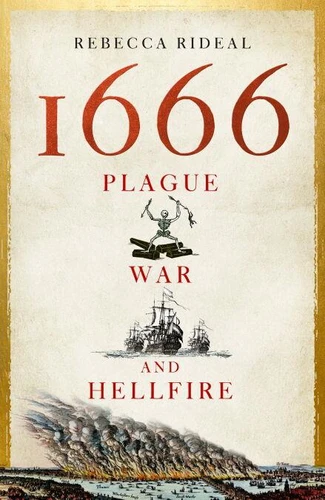1666. Plague, War and Hellfire
Par :Formats :
Disponible dans votre compte client Decitre ou Furet du Nord dès validation de votre commande. Le format ePub protégé est :
- Compatible avec une lecture sur My Vivlio (smartphone, tablette, ordinateur)
- Compatible avec une lecture sur liseuses Vivlio
- Pour les liseuses autres que Vivlio, vous devez utiliser le logiciel Adobe Digital Edition. Non compatible avec la lecture sur les liseuses Kindle, Remarkable et Sony
- Non compatible avec un achat hors France métropolitaine
 , qui est-ce ?
, qui est-ce ?Notre partenaire de plateforme de lecture numérique où vous retrouverez l'ensemble de vos ebooks gratuitement
Pour en savoir plus sur nos ebooks, consultez notre aide en ligne ici
- Nombre de pages304
- FormatePub
- ISBN978-1-4736-2355-2
- EAN9781473623552
- Date de parution24/08/2016
- Protection num.Adobe DRM
- Infos supplémentairesepub
- ÉditeurJohn Murray
Résumé
1666 was a watershed year for England. The outbreak of the Great Plague, the eruption of the second Dutch War and the Great Fire of London all struck the country in rapid succession and with devastating repercussions. Shedding light on these dramatic events, historian Rebecca Rideal reveals an unprecedented period of terror and triumph. Based on original archival research and drawing on little-known sources, 1666: Plague, War and Hellfire takes readers on a thrilling journey through a crucial turning point in English history, as seen through the eyes of an extraordinary cast of historical characters.
While the central events of this significant year were ones of devastation and defeat, 1666 also offers a glimpse of the incredible scientific and artistic progress being made at that time, from Isaac Newton's discovery of gravity to Robert Hooke's microscopic wonders. It was in this year that John Milton completed Paradise Lost, Frances Stewart posed for the now-iconic image of Britannia, and a young architect named Christopher Wren proposed a plan for a new London - a stone phoenix to rise from the charred ashes of the old city.
With flair and style, 1666 shows a city and a country on the cusp of modernity, and a series of events that forever altered the course of history.
While the central events of this significant year were ones of devastation and defeat, 1666 also offers a glimpse of the incredible scientific and artistic progress being made at that time, from Isaac Newton's discovery of gravity to Robert Hooke's microscopic wonders. It was in this year that John Milton completed Paradise Lost, Frances Stewart posed for the now-iconic image of Britannia, and a young architect named Christopher Wren proposed a plan for a new London - a stone phoenix to rise from the charred ashes of the old city.
With flair and style, 1666 shows a city and a country on the cusp of modernity, and a series of events that forever altered the course of history.
1666 was a watershed year for England. The outbreak of the Great Plague, the eruption of the second Dutch War and the Great Fire of London all struck the country in rapid succession and with devastating repercussions. Shedding light on these dramatic events, historian Rebecca Rideal reveals an unprecedented period of terror and triumph. Based on original archival research and drawing on little-known sources, 1666: Plague, War and Hellfire takes readers on a thrilling journey through a crucial turning point in English history, as seen through the eyes of an extraordinary cast of historical characters.
While the central events of this significant year were ones of devastation and defeat, 1666 also offers a glimpse of the incredible scientific and artistic progress being made at that time, from Isaac Newton's discovery of gravity to Robert Hooke's microscopic wonders. It was in this year that John Milton completed Paradise Lost, Frances Stewart posed for the now-iconic image of Britannia, and a young architect named Christopher Wren proposed a plan for a new London - a stone phoenix to rise from the charred ashes of the old city.
With flair and style, 1666 shows a city and a country on the cusp of modernity, and a series of events that forever altered the course of history.
While the central events of this significant year were ones of devastation and defeat, 1666 also offers a glimpse of the incredible scientific and artistic progress being made at that time, from Isaac Newton's discovery of gravity to Robert Hooke's microscopic wonders. It was in this year that John Milton completed Paradise Lost, Frances Stewart posed for the now-iconic image of Britannia, and a young architect named Christopher Wren proposed a plan for a new London - a stone phoenix to rise from the charred ashes of the old city.
With flair and style, 1666 shows a city and a country on the cusp of modernity, and a series of events that forever altered the course of history.



